
Teaching Problem Solving in Math
- Freebies , Math , Planning
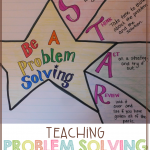
Every year my students can be fantastic at math…until they start to see math with words. For some reason, once math gets translated into reading, even my best readers start to panic. There is just something about word problems, or problem-solving, that causes children to think they don’t know how to complete them.
Every year in math, I start off by teaching my students problem-solving skills and strategies. Every year they moan and groan that they know them. Every year – paragraph one above. It was a vicious cycle. I needed something new.
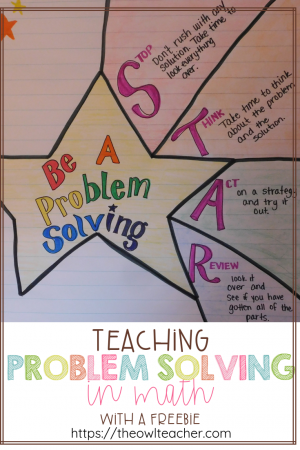
I put together a problem-solving unit that would focus a bit more on strategies and steps in hopes that that would create problem-solving stars.
The Problem Solving Strategies
First, I wanted to make sure my students all learned the different strategies to solve problems, such as guess-and-check, using visuals (draw a picture, act it out, and modeling it), working backward, and organizational methods (tables, charts, and lists). In the past, I had used worksheet pages that would introduce one and provide the students with plenty of problems practicing that one strategy. I did like that because students could focus more on practicing the strategy itself, but I also wanted students to know when to use it, too, so I made sure they had both to practice.
I provided students with plenty of practice of the strategies, such as in this guess-and-check game.
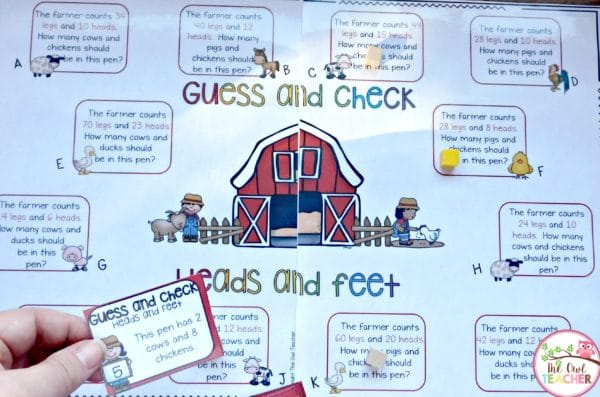
There’s also this visuals strategy wheel practice.
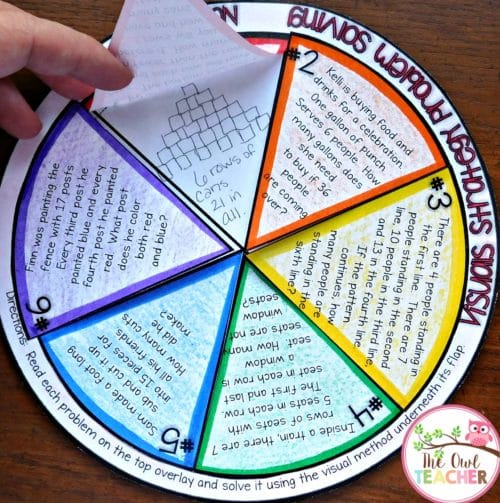
I also provided them with paper dolls and a variety of clothing to create an organized list to determine just how many outfits their “friend” would have.
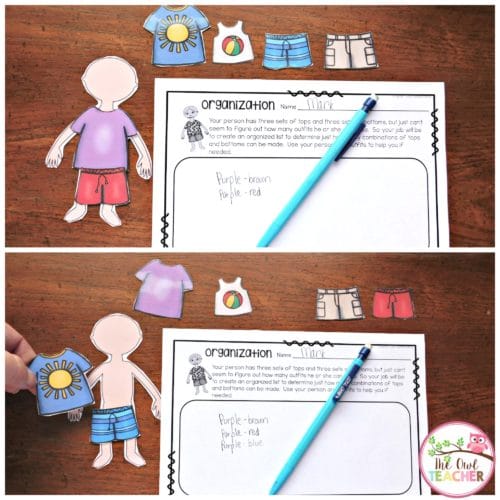
Then, as I said above, we practiced in a variety of ways to make sure we knew exactly when to use them. I really wanted to make sure they had this down!
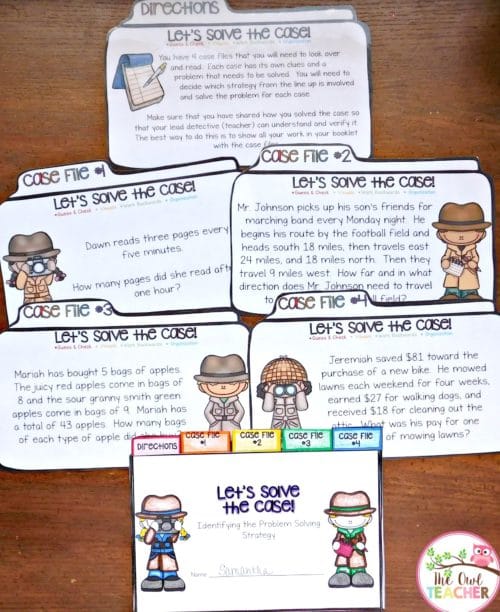
Anyway, after I knew they had down the various strategies and when to use them, then we went into the actual problem-solving steps.
The Problem Solving Steps
I wanted students to understand that when they see a story problem, it isn’t scary. Really, it’s just the equation written out in words in a real-life situation. Then, I provided them with the “keys to success.”
S tep 1 – Understand the Problem. To help students understand the problem, I provided them with sample problems, and together we did five important things:
- read the problem carefully
- restated the problem in our own words
- crossed out unimportant information
- circled any important information
- stated the goal or question to be solved
We did this over and over with example problems.
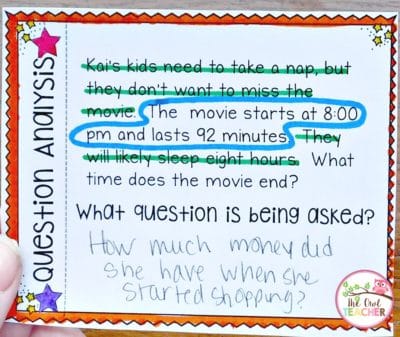
Once I felt the students had it down, we practiced it in a game of problem-solving relay. Students raced one another to see how quickly they could get down to the nitty-gritty of the word problems. We weren’t solving the problems – yet.
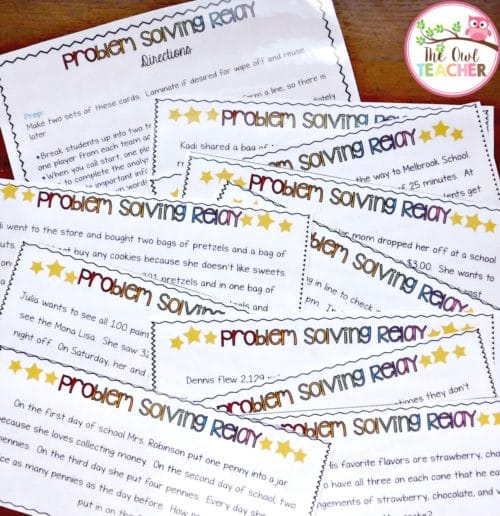
Then, we were on to Step 2 – Make a Plan . We talked about how this was where we were going to choose which strategy we were going to use. We also discussed how this was where we were going to figure out what operation to use. I taught the students Sheila Melton’s operation concept map.
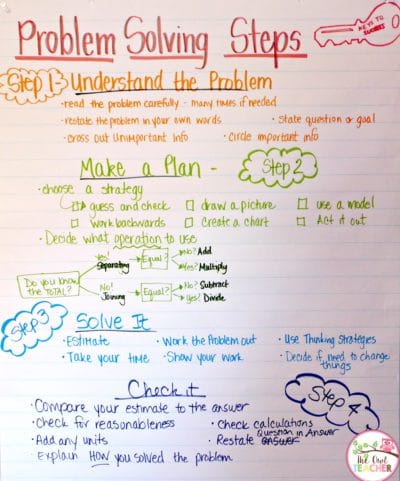
We talked about how if you know the total and know if it is equal or not, that will determine what operation you are doing. So, we took an example problem, such as:
Sheldon wants to make a cupcake for each of his 28 classmates. He can make 7 cupcakes with one box of cupcake mix. How many boxes will he need to buy?
We started off by asking ourselves, “Do we know the total?” We know there are a total of 28 classmates. So, yes, we are separating. Then, we ask, “Is it equal?” Yes, he wants to make a cupcake for EACH of his classmates. So, we are dividing: 28 divided by 7 = 4. He will need to buy 4 boxes. (I actually went ahead and solved it here – which is the next step, too.)
Step 3 – Solving the problem . We talked about how solving the problem involves the following:
- taking our time
- working the problem out
- showing all our work
- estimating the answer
- using thinking strategies
We talked specifically about thinking strategies. Just like in reading, there are thinking strategies in math. I wanted students to be aware that sometimes when we are working on a problem, a particular strategy may not be working, and we may need to switch strategies. We also discussed that sometimes we may need to rethink the problem, to think of related content, or to even start over. We discussed these thinking strategies:
- switch strategies or try a different one
- rethink the problem
- think of related content
- decide if you need to make changes
- check your work
- but most important…don’t give up!
To make sure they were getting in practice utilizing these thinking strategies, I gave each group chart paper with a letter from a fellow “student” (not a real student), and they had to give advice on how to help them solve their problem using the thinking strategies above.
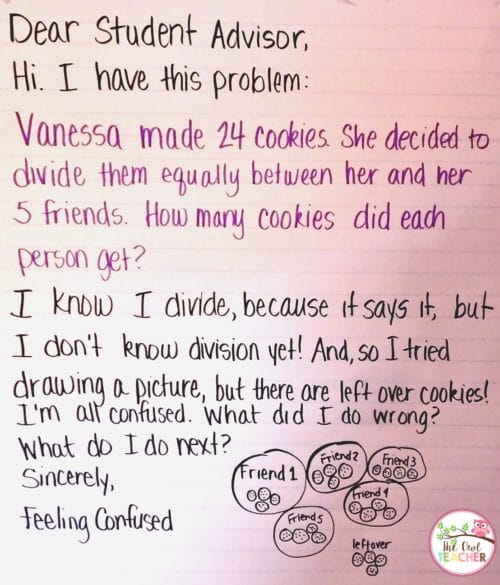
Finally, Step 4 – Check It. This is the step that students often miss. I wanted to emphasize just how important it is! I went over it with them, discussing that when they check their problems, they should always look for these things:
- compare your answer to your estimate
- check for reasonableness
- check your calculations
- add the units
- restate the question in the answer
- explain how you solved the problem
Then, I gave students practice cards. I provided them with example cards of “students” who had completed their assignments already, and I wanted them to be the teacher. They needed to check the work and make sure it was completed correctly. If it wasn’t, then they needed to tell what they missed and correct it.
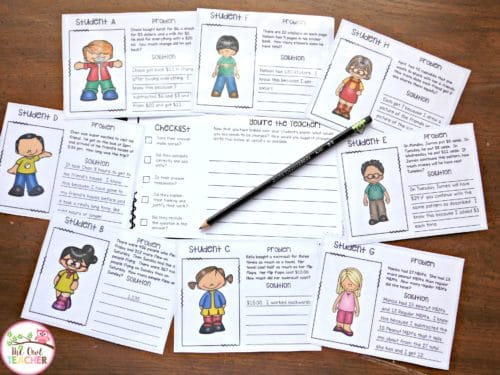
To demonstrate their understanding of the entire unit, we completed an adorable lap book (my first time ever putting together one or even creating one – I was surprised how well it turned out, actually). It was a great way to put everything we discussed in there.
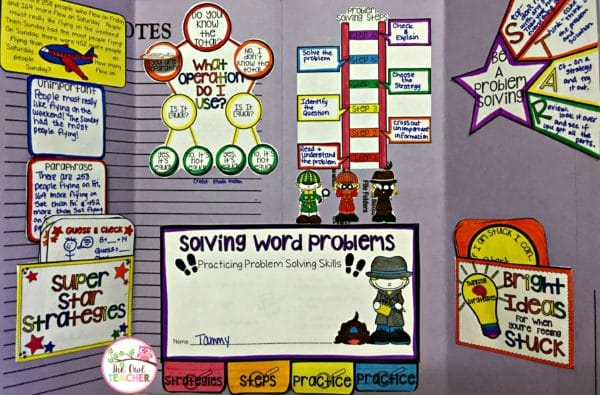
Once we were all done, students were officially Problem Solving S.T.A.R.S. I just reminded students frequently of this acronym.
Stop – Don’t rush with any solution; just take your time and look everything over.
Think – Take your time to think about the problem and solution.
Act – Act on a strategy and try it out.
Review – Look it over and see if you got all the parts.
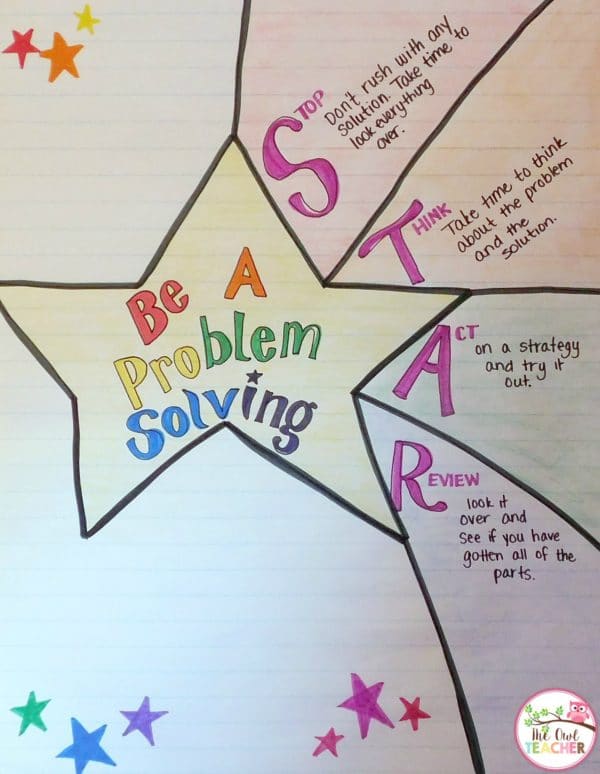
Wow, you are a true trooper sticking it out in this lengthy post! To sum up the majority of what I have written here, I have some problem-solving bookmarks FREE to help you remember and to help your students!
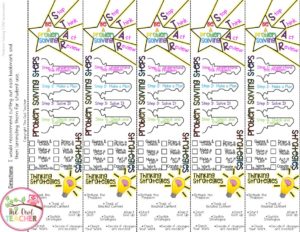
You can grab these problem-solving bookmarks for FREE by clicking here .
You can do any of these ideas without having to purchase anything. However, if you are looking to save some time and energy, then they are all found in my Math Workshop Problem Solving Unit . The unit is for grade three, but it may work for other grade levels. The practice problems are all for the early third-grade level.

- freebie , Math Workshop , Problem Solving

FIND IT NOW!
Check me out on tpt.

CHECK THESE OUT

Three Types of Rocks and Minerals with Rock Cycle Circle Book

Partitioning Shapes Equal Share Fractions Halves, Thirds, Fourths Math Puzzles
Want to save time?
COPYRIGHT © 2016-2024. The Owl Teacher | Privacy page | Disclosure Page | Shipping | Returns/Refunds
BOGO on EVERYTHING!
Want a daily email of lesson plans that span all subjects and age groups?
Subjects all subjects all subjects the arts all the arts visual arts performing arts value of the arts back business & economics all business & economics global economics macroeconomics microeconomics personal finance business back design, engineering & technology all design, engineering & technology design engineering technology back health all health growth & development medical conditions consumer health public health nutrition physical fitness emotional health sex education back literature & language all literature & language literature linguistics writing/composition speaking back mathematics all mathematics algebra data analysis & probability geometry measurement numbers & operations back philosophy & religion all philosophy & religion philosophy religion back psychology all psychology history, approaches and methods biological bases of behavior consciousness, sensation and perception cognition and learning motivation and emotion developmental psychology personality psychological disorders and treatment social psychology back science & technology all science & technology earth and space science life sciences physical science environmental science nature of science back social studies all social studies anthropology area studies civics geography history media and journalism sociology back teaching & education all teaching & education education leadership education policy structure and function of schools teaching strategies back thinking & learning all thinking & learning attention and engagement memory critical thinking problem solving creativity collaboration information literacy organization and time management back, filter by none.
- Elementary/Primary
- Middle School/Lower Secondary
- High School/Upper Secondary
- College/University
- TED-Ed Animations
- TED Talk Lessons
- TED-Ed Best of Web
- Under 3 minutes
- Under 6 minutes
- Under 9 minutes
- Under 12 minutes
- Under 18 minutes
- Over 18 minutes
- Algerian Arabic
- Azerbaijani
- Cantonese (Hong Kong)
- Chinese (Hong Kong)
- Chinese (Singapore)
- Chinese (Taiwan)
- Chinese Simplified
- Chinese Traditional
- Chinese Traditional (Taiwan)
- Dutch (Belgium)
- Dutch (Netherlands)
- French (Canada)
- French (France)
- French (Switzerland)
- Kurdish (Central)
- Luxembourgish
- Persian (Afghanistan)
- Persian (Iran)
- Portuguese (Brazil)
- Portuguese (Portugal)
- Spanish (Argentina)
- Spanish (Latin America)
- Spanish (Mexico)
- Spanish (Spain)
- Spanish (United States)
- Western Frisian
sort by none
- Longest video
- Shortest video
- Most video views
- Least video views
- Most questions answered
- Least questions answered

This piece of paper could revolutionize human waste
Lesson duration 05:35
2,420,867 Views

Can you solve the magical maze riddle?
Lesson duration 04:51
308,777 Views

How to clear icy roads, with science
Lesson duration 06:13
191,145 Views

How to make smart decisions more easily
Lesson duration 05:16
1,028,497 Views

Can you solve a mystery before Sherlock Holmes?
Lesson duration 05:17
455,981 Views

Can you solve the secret assassin society riddle?
Lesson duration 05:01
651,235 Views

How to overcome your mistakes
Lesson duration 04:52
873,231 Views

What the fossil fuel industry doesn't want you to know - Al Gore
Lesson duration 25:45
734,705 Views

Can you solve the cursed dice riddle?
Lesson duration 04:31
648,228 Views

How the water you flush becomes the water you drink
Lesson duration 05:23
382,712 Views

The growing megafire crisis — and how to contain it - George T. Whitesides
Lesson duration 10:42
56,536 Views

Can you solve the time traveling car riddle?
Lesson duration 05:18
609,742 Views

4 epidemics that almost happened (but didn't)
Lesson duration 06:26
393,013 Views

The return of Mongolia's "wild" horses
Lesson duration 04:53
203,921 Views

Whatever happened to the hole in the ozone layer?
Lesson duration 05:13
513,174 Views

The most important century in human history
Lesson duration 05:20
336,333 Views

This one weird trick will get you infinite gold
Lesson duration 05:08
954,745 Views

How to quit your job — without ruining your career - Gala Jackson
102,591 Views

How to design climate-resilient buildings - Alyssa-Amor Gibbons
Lesson duration 14:12
42,741 Views

The case for free, universal basic services - Aaron Bastani
Lesson duration 19:09
79,863 Views

Can you steal the most powerful wand in the wizarding world?
748,645 Views

How college loans exploit students for profit - Sajay Samuel
Lesson duration 11:49
229,072 Views

What’s the smartest age?
1,532,743 Views

The 4 greatest threats to the survival of humanity
Lesson duration 05:24
483,966 Views

FREE K-12 standards-aligned STEM
curriculum for educators everywhere!
Find more at TeachEngineering.org .
- TeachEngineering
- Problem Solving
Lesson Problem Solving
Grade Level: 8 (6-8)
(two 40-minute class periods)
Lesson Dependency: The Energy Problem
Subject Areas: Physical Science, Science and Technology

- Print lesson and its associated curriculum
Curriculum in this Unit Units serve as guides to a particular content or subject area. Nested under units are lessons (in purple) and hands-on activities (in blue). Note that not all lessons and activities will exist under a unit, and instead may exist as "standalone" curriculum.
- Energy Forms and States Demonstrations
- Energy Conversions
- Watt Meters to Measure Energy Consumption
- Household Energy Audit
- Light vs. Heat Bulbs
- Efficiency of an Electromechanical System
- Efficiency of a Water Heating System
- Solving Energy Problems
- Energy Projects
TE Newsletter
Engineering connection, learning objectives, worksheets and attachments, more curriculum like this, introduction/motivation, associated activities, user comments & tips.

Scientists, engineers and ordinary people use problem solving each day to work out solutions to various problems. Using a systematic and iterative procedure to solve a problem is efficient and provides a logical flow of knowledge and progress.
- Students demonstrate an understanding of the Technological Method of Problem Solving.
- Students are able to apply the Technological Method of Problem Solving to a real-life problem.
Educational Standards Each TeachEngineering lesson or activity is correlated to one or more K-12 science, technology, engineering or math (STEM) educational standards. All 100,000+ K-12 STEM standards covered in TeachEngineering are collected, maintained and packaged by the Achievement Standards Network (ASN) , a project of D2L (www.achievementstandards.org). In the ASN, standards are hierarchically structured: first by source; e.g. , by state; within source by type; e.g. , science or mathematics; within type by subtype, then by grade, etc .
Ngss: next generation science standards - science.
View aligned curriculum
Do you agree with this alignment? Thanks for your feedback!

International Technology and Engineering Educators Association - Technology
State standards, national science education standards - science.
Scientists, engineers, and ordinary people use problem solving each day to work out solutions to various problems. Using a systematic and iterative procedure to solve a problem is efficient and provides a logical flow of knowledge and progress.
In this unit, we use what is called "The Technological Method of Problem Solving." This is a seven-step procedure that is highly iterative—you may go back and forth among the listed steps, and may not always follow them in order. Remember that in most engineering projects, more than one good answer exists. The goal is to get to the best solution for a given problem. Following the lesson conduct the associated activities Egg Drop and Solving Energy Problems for students to employ problem solving methods and techniques.
Lesson Background and Concepts for Teachers
The overall concept that is important in this lesson is: Using a standard method or procedure to solve problems makes the process easier and more effective.
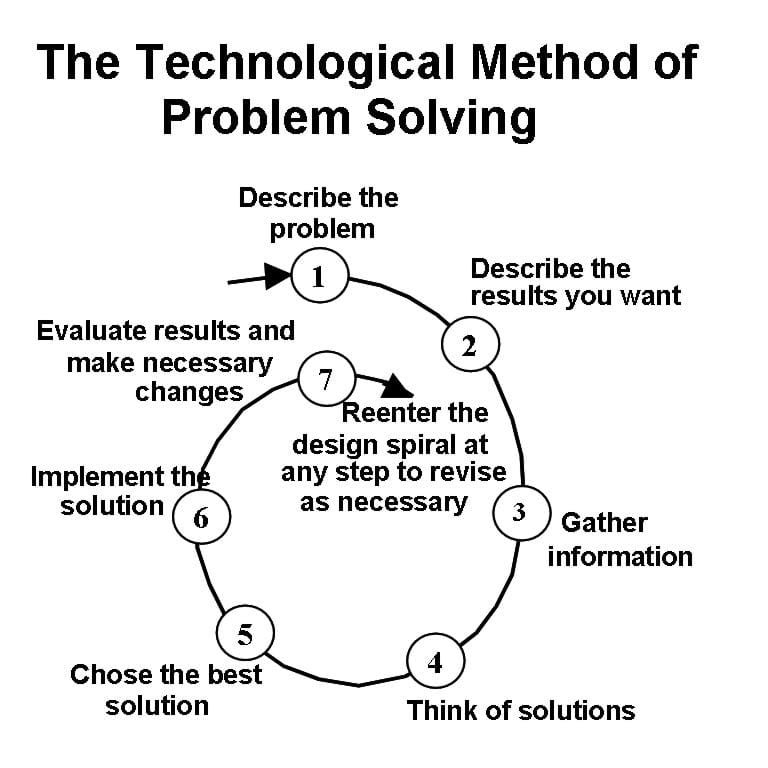
The specific process of problem solving used in this unit was adapted from an eighth-grade technology textbook written for New York State standard technology curriculum. The process is shown in Figure 1, with details included below. The spiral shape shows that this is an iterative, not linear, process. The process can skip ahead (for example, build a model early in the process to test a proof of concept) and go backwards (learn more about the problem or potential solutions if early ideas do not work well).
This process provides a reference that can be reiterated throughout the unit as students learn new material or ideas that are relevant to the completion of their unit projects.
Brainstorming about what we know about a problem or project and what we need to find out to move forward in a project is often a good starting point when faced with a new problem. This type of questioning provides a basis and relevance that is useful in other energy science and technology units. In this unit, the general problem that is addressed is the fact that Americans use a lot of energy, with the consequences that we have a dwindling supply of fossil fuels, and we are emitting a lot of carbon dioxide and other air pollutants. The specific project that students are assigned to address is an aspect of this problem that requires them to identify an action they can take in their own live to reduce their overall energy (or fossil fuel) consumption.
The Seven Steps of Problem Solving
1. Identify the problem
Clearly state the problem. (Short, sweet and to the point. This is the "big picture" problem, not the specific project you have been assigned.)
2. Establish what you want to achieve
- Completion of a specific project that will help to solve the overall problem.
- In one sentence answer the following question: How will I know I've completed this project?
- List criteria and constraints: Criteria are things you want the solution to have. Constraints are limitations, sometimes called specifications, or restrictions that should be part of the solution. They could be the type of materials, the size or weight the solution must meet, the specific tools or machines you have available, time you have to complete the task and cost of construction or materials.
3. Gather information and research
- Research is sometimes needed both to better understand the problem itself as well as possible solutions.
- Don't reinvent the wheel – looking at other solutions can lead to better solutions.
- Use past experiences.
4. Brainstorm possible solutions
List and/or sketch (as appropriate) as many solutions as you can think of.
5. Choose the best solution
Evaluate solution by: 1) Comparing possible solution against constraints and criteria 2) Making trade-offs to identify "best."
6. Implement the solution
- Develop plans that include (as required): drawings with measurements, details of construction, construction procedure.
- Define tasks and resources necessary for implementation.
- Implement actual plan as appropriate for your particular project.
7. Test and evaluate the solution
- Compare the solution against the criteria and constraints.
- Define how you might modify the solution for different or better results.
- Egg Drop - Use this demonstration or activity to introduce and use the problem solving method. Encourages creative design.
- Solving Energy Problems - Unit project is assigned and students begin with problem solving techniques to begin to address project. Mostly they learn that they do not know enough yet to solve the problem.
- Energy Projects - Students use what they learned about energy systems to create a project related to identifying and carrying out a personal change to reduce energy consumption.
The results of the problem solving activity provide a basis for the entire semester project. Collect and review the worksheets to make sure that students are started on the right track.

Learn the basics of the analysis of forces engineers perform at the truss joints to calculate the strength of a truss bridge known as the “method of joints.” Find the tensions and compressions to solve systems of linear equations where the size depends on the number of elements and nodes in the trus...

Through role playing and problem solving, this lesson sets the stage for a friendly competition between groups to design and build a shielding device to protect humans traveling in space. The instructor asks students—how might we design radiation shielding for space travel?

A process for technical problem solving is introduced and applied to a fun demonstration. Given the success with the demo, the iterative nature of the process can be illustrated.

The culminating energy project is introduced and the technical problem solving process is applied to get students started on the project. By the end of the class, students should have a good perspective on what they have already learned and what they still need to learn to complete the project.

Hacker, M, Barden B., Living with Technology , 2nd edition. Albany NY: Delmar Publishers, 1993.
Other Related Information
This lesson was originally published by the Clarkson University K-12 Project Based Learning Partnership Program and may be accessed at http://internal.clarkson.edu/highschool/k12/project/energysystems.html.
Contributors
Supporting program, acknowledgements.
This lesson was developed under National Science Foundation grants no. DUE 0428127 and DGE 0338216. However, these contents do not necessarily represent the policies of the National Science Foundation, and you should not assume endorsement by the federal government.
Last modified: August 16, 2023
If you're seeing this message, it means we're having trouble loading external resources on our website.
If you're behind a web filter, please make sure that the domains *.kastatic.org and *.kasandbox.org are unblocked.
To log in and use all the features of Khan Academy, please enable JavaScript in your browser.
Unit 1: Algebra foundations
Unit 2: solving equations & inequalities, unit 3: working with units, unit 4: linear equations & graphs, unit 5: forms of linear equations, unit 6: systems of equations, unit 7: inequalities (systems & graphs), unit 8: functions, unit 9: sequences, unit 10: absolute value & piecewise functions, unit 11: exponents & radicals, unit 12: exponential growth & decay, unit 13: quadratics: multiplying & factoring, unit 14: quadratic functions & equations, unit 15: irrational numbers, unit 16: creativity in algebra.

- school Campus Bookshelves
- menu_book Bookshelves
- perm_media Learning Objects
- login Login
- how_to_reg Request Instructor Account
- hub Instructor Commons
- Download Page (PDF)
- Download Full Book (PDF)
- Periodic Table
- Physics Constants
- Scientific Calculator
- Reference & Cite
- Tools expand_more
- Readability
selected template will load here
This action is not available.

2.3.1: George Polya's Four Step Problem Solving Process
- Last updated
- Save as PDF
- Page ID 90483
Step 1: Understand the Problem
- Do you understand all the words?
- Can you restate the problem in your own words?
- Do you know what is given?
- Do you know what the goal is?
- Is there enough information?
- Is there extraneous information?
- Is this problem similar to another problem you have solved?
Step 2: Devise a Plan: Below are some strategies one might use to solve a problem. Can one (or more) of the following strategies be used? (A strategy is defined as an artful means to an end.)
Your cookie preferences
In order to provide you with the best possible experience on the LifeSkills website we use cookies and similar technology to collect data from your device and browser while you are here. Collecting this data helps us to personalise content for you, understand how you use the website, allow access to social media features and deliver personalised service and advert message content. You can find out more in our Cookie Policy . Please select ‘Accept all’ to consent to us collecting your data in this way. To see other data collection options, select ‘Manage data preferences’.
The types of similar technologies used in this website fall into one of four categories - Strictly Necessary, Performance, Functionality & Profile and Targeting. You can find out more information in our Cookie Policy .
Please indicate the categories you wish to consent to by selecting ‘Manage data preferences’ and using the sliders below and then click “Save preferences” to retain your preferences for future visits. You can change these preferences at any time by clicking Cookie Policy on our website.
Strictly necessary
Data collected in this category is essential to provide our services to you. The data is necessary for the website to operate and to maintain your security and privacy while using the website. Data is not used for marketing purposes or for the purposes covered by the other three categories below. This category can’t be disabled.
Performance
These help us improve the experience for all users of the website. Data collected in this category is to inform us how the website is used, improve how our website works and to help us to identify issues you may have when using our website. This data is not used to target you with online advertising.
Data collected in this category is used to help make our messages more relevant to you. The data is shared with other third parties, such as advertisers and platforms we may use to deliver personalised advertisements and messages. If you don’t wish to consent to this category, it’s important to note that you may still receive generic advertising or service messages, but they will be less relevant to you
Functionality & Profile
Data collected in this category enables the website to remember choices you make. This means a more personalised experience for features of the website that can be customised. It may also be used to provide services you've asked for, such as watching a video or commenting on a blog.
For learners from school through to university and beyond
What stage are you at?
For people like teachers, youth group leaders, mentors, local authorities, charities, job centre staff, and parents or carers
Work with a group or a class
Coach an adult
Tools, tips and activities to help your family
Resources for educators
- Login Sign up for free
Save to a group
Would you like to create a subgroup to help organise your saved items?
- I'm here to help others
- Lesson plans
Problem solving
Problem solving lesson plan

Time to complete
Download the full lesson plan pack including all related resources
Choose to download one or more individual resources
Problem Solving: Lesson plan
Problem solving: Presentation slides
Demonstrating your skills quick fire activity
Problem solving in practice: Interactive worksheet
Our problem solving content focuses on one of these skills and develops understanding of the six stages of problem solving, as well as identifying different types of situations in which young people might already be using these skills. Furthermore, it encourages them to use an adaptive approach, explaining that different types of problems can be approached in different ways.
The activities on this page support your teaching of these skills through an independent activity, quick activities or a full length, curriculum-linked lesson plan.
Teaching resources:
- Problem solving: Lesson plan and presentation slides – full lesson plan including icebreaker for use with a group of students in the classroom
- Demonstrating your skills: Quick-fire activity – 10 minute activity for a group of students in the classroom, can be used as an icebreaker for the lesson plan
- Problem solving in practice: Interactive worksheet – activity for independent learning whether remote or in class
Lesson plan
(60 -75 minutes)
This lesson is designed to equip young people with an adaptable approach to solving problems, large or small. It includes a short film and scenarios that encourage development of practical problem solving skills which can be useful for learning, day to day life, and when in employment.
By the end of the lesson, students will be able to:
- Identify problems of different scales and what is needed to solve them
- Illustrate the use of an adaptable approach to solving problems
- Understand that problem solving is a core transferable skill and identify its usefulness in a work setting
- Work on a problem solving activity in a team
The lesson aims to reinforce students’ understanding of the potential future applications of this skill as they move into the world of work, particularly in an activity differentiated for an older or more able group on creating new opportunities.
Quick-fire activity
(5 - 10 minutes)
The demonstrating your skills quick-fire activity focuses on helping young people understand the key skills that are needed in the workplace, including the importance of problem solving.
Students will be asked to name the skills being demonstrated in a variety of scenarios, and identify ways they’re already using those skills in this short activity.
You might find it useful as a starter or icebreaker activity to begin a lesson, or at the end to allow students to put what they have just learnt in the Problem solving lesson into practice.
Interactive worksheet
(20 - 25 minutes)
Please note that students below the age of 14 cannot sign up for their own LifeSkills account. Any independent tasks must be printed or downloaded and provided digitally for them to complete as they are currently hosted on educator pages.
The Problem solving in practice interactive worksheet introduces some of the themes from the full lesson plan and gives students some practical strategies for problem solving, including introducing the six stages of problem solving. The worksheet can be printed or completed digitally, so can be used flexibly to give students practise putting their problem solving skills into action. You might choose to assign it:
- As homework following the Problem solving lesson
- For independent study
- For remote learning
Looking for more ways to boost self confidence with LifeSkills?
Other lessons that may prove useful for students to build on these activities include the Adaptability and Innovation and idea generation lessons. Alternatively, consider encouraging them to apply their skills through Steps to starting a business or the Social action toolkit .
Why not build problem solving in as a focus in your students’ wider curriculum? Refer to our Content guide to find out how this resources can be used as part of your teaching.
Curriculum tags
A free account gives you access to all educator content, tools and resources
Already have an account, get started, thank you for liking.
Help us to continue creating relevant content for you by leaving some additional feedback .
Additional feedback
All feedback will be anonymous and will help us to provide more effective content for you and your student.
Thank you for letting us know what you thought of .
Why not try one of these next?
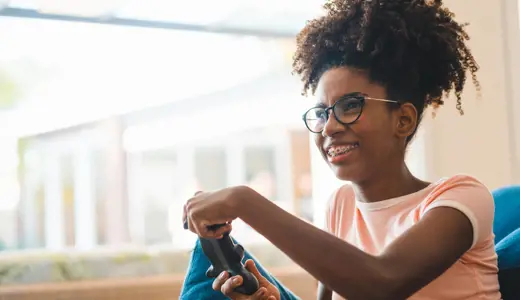
Staying positive (resilience)
Staying positive and learning through experience are key to succeeding in challenging situations. Try this lesson and help your students succeed at work.

Good leadership styles and effective teamwork can help students excel in their future workplace. Read more about team leader skills in this lesson.

Social action toolkit
Build a comprehensive social action programme and support young people to access enriching experiences that build transferable skills for work.
Second Step® Sample Lessons
Complete sets of materials from select Second Step curricula, the Second Step® Bullying Prevention Unit, and the Second Step® Child Protection Unit are available for Early Learning through Grade 8.
Digital Programs
Classroom kits.
Bullying Prevention Unit (Available for Kindergarten–Grade 5)
Child Protection Unit (Available for Early Learning–Grade 5)
Out-of-School Time (Available for Kindergarten–Grade 5)
Available for Kindergarten through Grade 8 Explore samples from all grades below
Kindergarten
__Lesson 18: Apologizing Can Help __
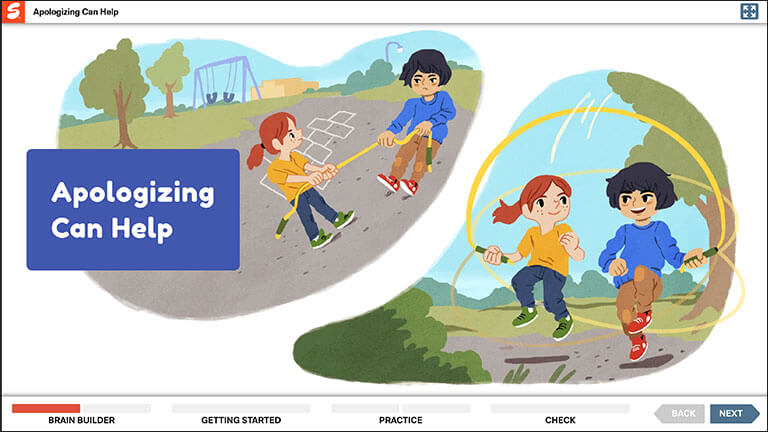
In this lesson, students will learn about apologizing as a way of showing kindness and as a tool for problem-solving in a variety of scenarios. Lesson Plan (PDF) Lesson Presentation
Lesson 9: Feeling Frustrated
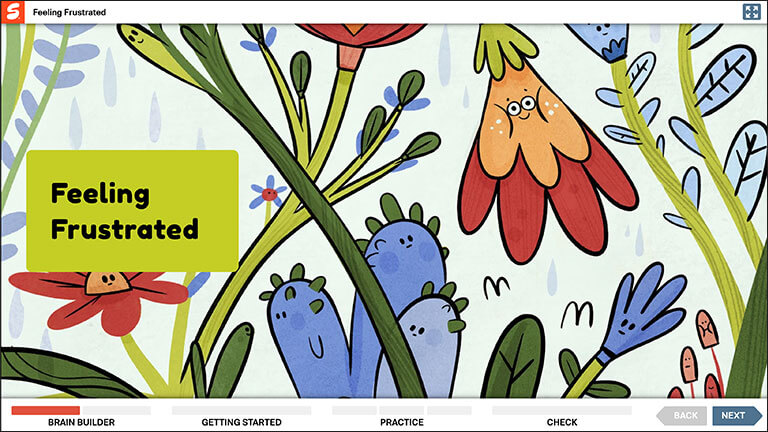
In this lesson, students will learn which clues tell them when others might be frustrated, and a new way to feel calm when they’re feeling frustrated themselves. Lesson Plan (PDF) Lesson Presentation
Lesson 16: The Way to Say a Problem
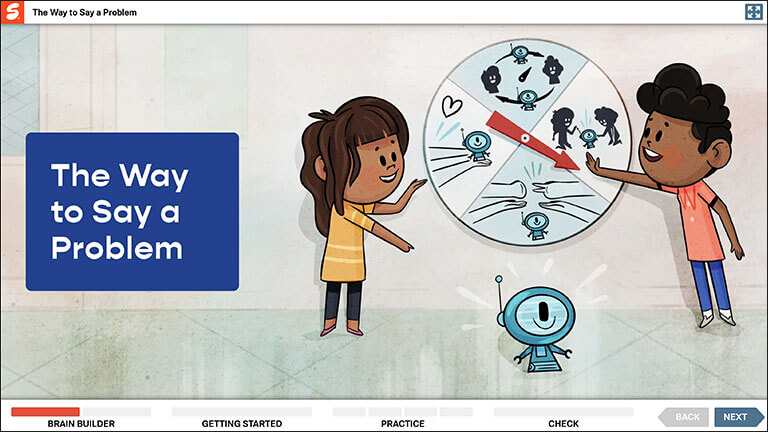
In this lesson, students will start learning to be better problem-solvers by managing strong feelings and stating problems without blame. Lesson Plan (PDF) Lesson Presentation Lesson Handout (PDF)
Lesson 14: Asking Questions

In this lesson, students will learn about asking questions to find out how someone else is feeling and to understand what their friends might want or need. Lesson Plan (PDF) Lesson Presentation Lesson Handout (PDF)
Lesson 17: Saying It Respectfully
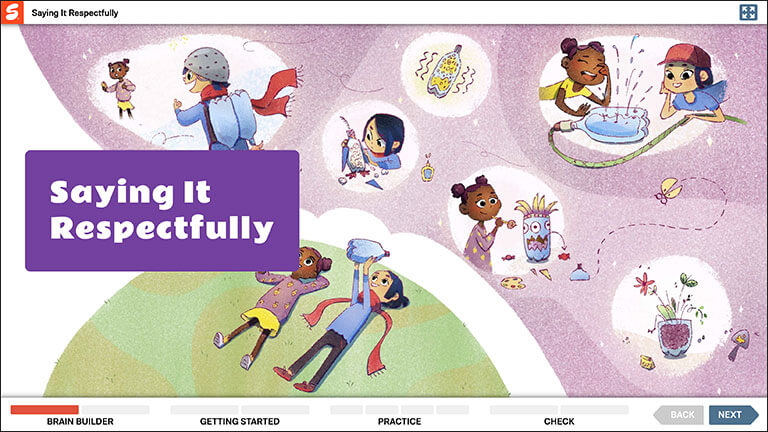
In this lesson, students will learn how to consider another person’s point of view and to say what they want or need in a respectful way. Lesson Plan (PDF) Lesson Presentation Lesson Handout A (PDF) Lesson Handout B (PDF)
Lesson 17: When? Where? Who?
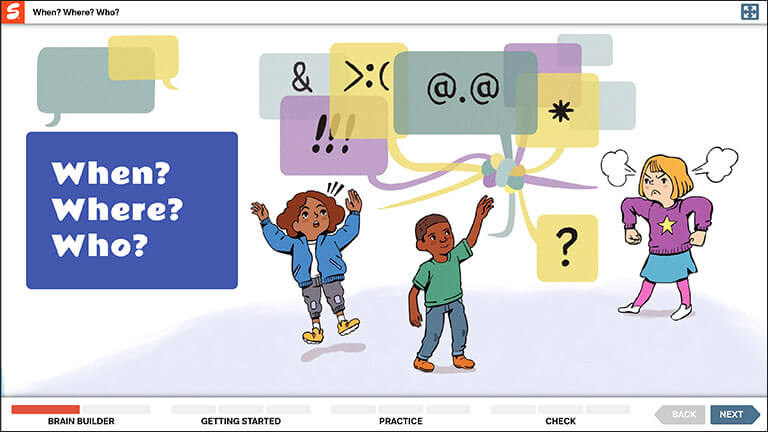
In this lesson, students will learn how to identify when and where to work on solving a problem, and who should be included. Lesson Plan (PDF) Lesson Presentation
Unit 4, Lesson 23: Respectful Communication
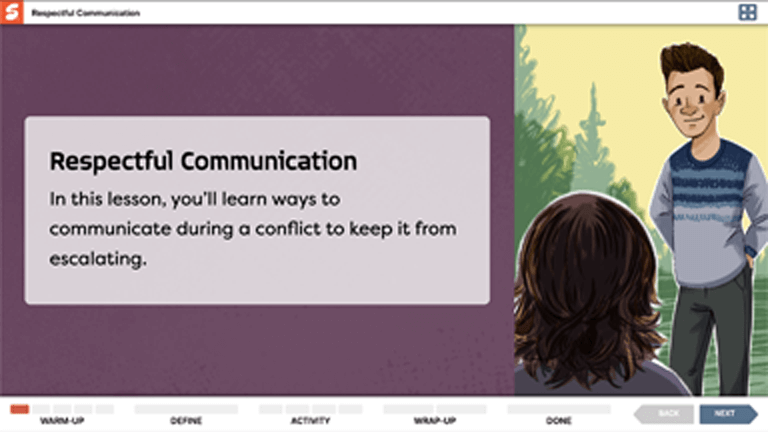
In this lesson, students will learn ways to communicate during a conflict to keep it from escalating through reflecting on their own experiences, defining respectful communication, and practicing using language that will help resolve conflicts. Sample This Lesson Lesson Plan (PDF) Student Handout (PDF)
Unit 3, Lesson 18: Practicing Positive Self-Talk
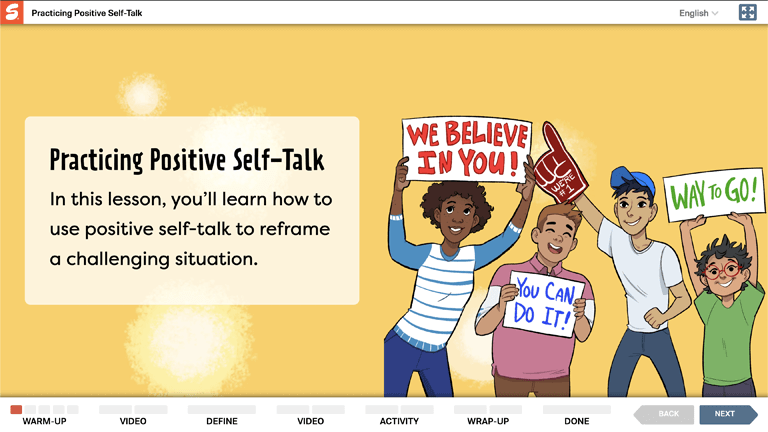
In this lesson, students will learn how to use positive self-talk to reframe challenging situations, including discussing why it isn’t always easy to see the positives and practicing noticing the positive things in their everyday lives. Sample This Lesson Lesson Plan (PDF) Student Handout (PDF)
Unit 2, Lesson 10: Environmental Factors that Contribute to Bullying
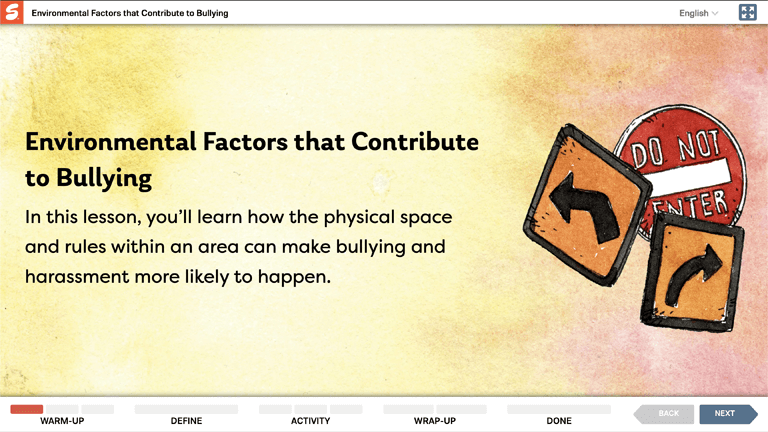
In this lesson, students will learn how the physical layout of and rules within a space can make bullying and harassment more likely to happen, from identifying environmental factors to discussing rules and regulations within their own school community. Sample This Lesson Lesson Plan (PDF) Student Handout (PDF)
Available for Early Learning through Grade 5 Explore samples from all grades below
Early Learning
Weekly Theme 6: Asking for What You Need or Want
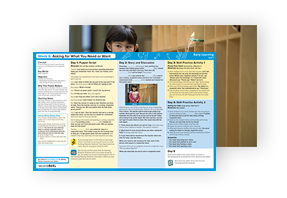
Weekly Theme Card

Take-Home Activity
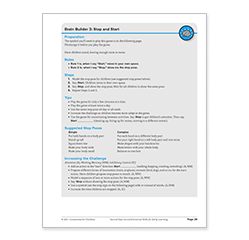
Brain Builder: Stop and Start
”How to Learn Song”

Listening Rules
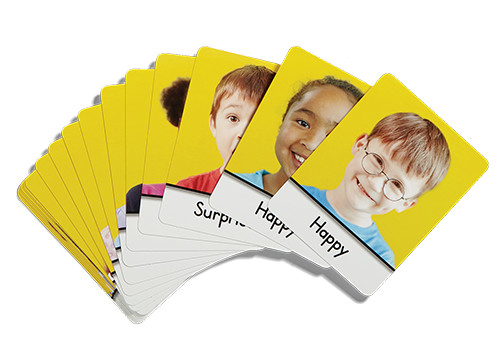
Feelings Cards
Lesson 2: Focusing Attention

Weekly Lesson Card
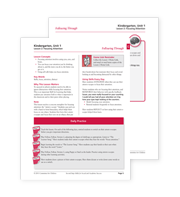
Following Through Card

“The Learner Song”

Brain Builder: Follow, Follow

Skills for Learning Poster
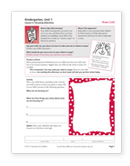
Lesson 11: Showing Care and Concern
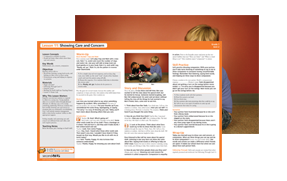
Brain Builder: Clap and Wait
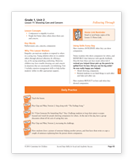
Empathy Poster
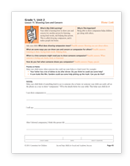
Lesson 17: Solving Problems, Part 1
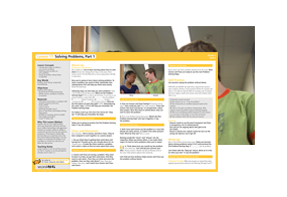
Skills for Learning
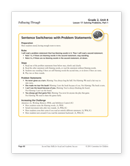
Brain Builder: Sentence Switcheroo

How to Calm Down Poster
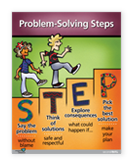
Problem-Solving Steps Poster
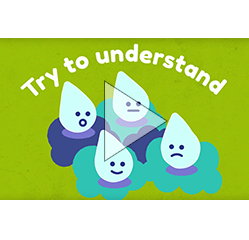
“The Empathy Song”

Problem Solving with Anthony
Lesson 8: Accepting Differences
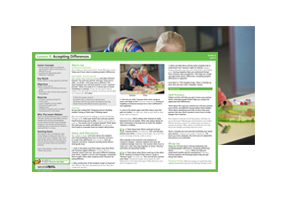
Brain Builder: Common Ground
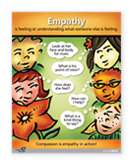
Student Handout
Lesson 15: Handling Put Downs
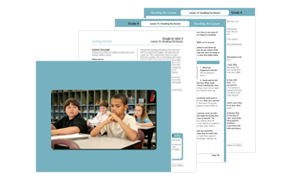
Teaching the Lesson Card
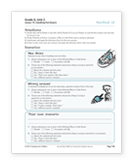
Lesson 15 Video (Parts 1 & 2)
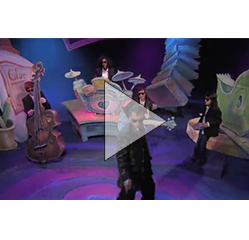
“Calm Down” Music Video
Lesson 21: Dealing with Peer Pressure

Lesson 21 Video (Parts 1, 2 & 3)

“Step Up” Music Video
Bullying Prevention Unit
Available for Kindergarten through Grade 5 Explore samples from Grades 2 and 5 below
Lesson 3: Refusing Bullying
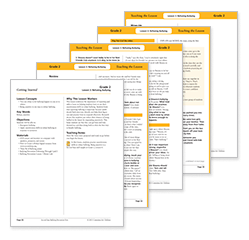
Lesson Samples
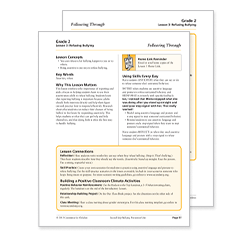
Classroom Activity
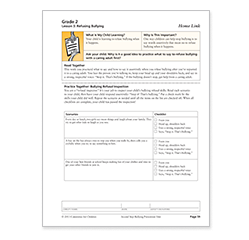
Addy’s Story
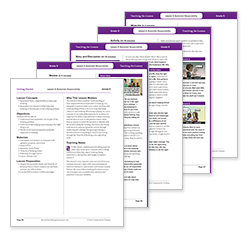
Noah and Olivia
Child Protection Unit
Available for Early Learning through Grade 5 Explore samples from Early Learning and Grades 2 and 5 below
Weekly Theme 3: Safe and Unsafe Touches

Weekly Theme Samples
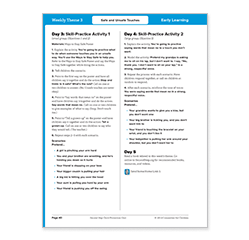
Ways to Stay Safe Poster
“The Safety Rules Song”
“Stop and Think”
Lesson 3: Safe and Unsafe Touches
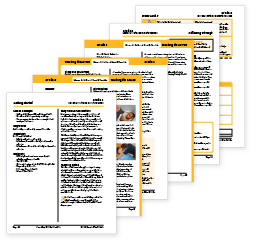
“Three Ways to Stay Safe”
Lesson 3: Unsafe and Unwanted Touches

“I’m in Charge” Music Video
Out-of-School Time
Available for Kindergarten through Grade 5 Explore samples from Kindergarten and Grade 1 below
Kindergarten–Grade 1
Unit 1, Topic 2: Facing Challenges with Confidence
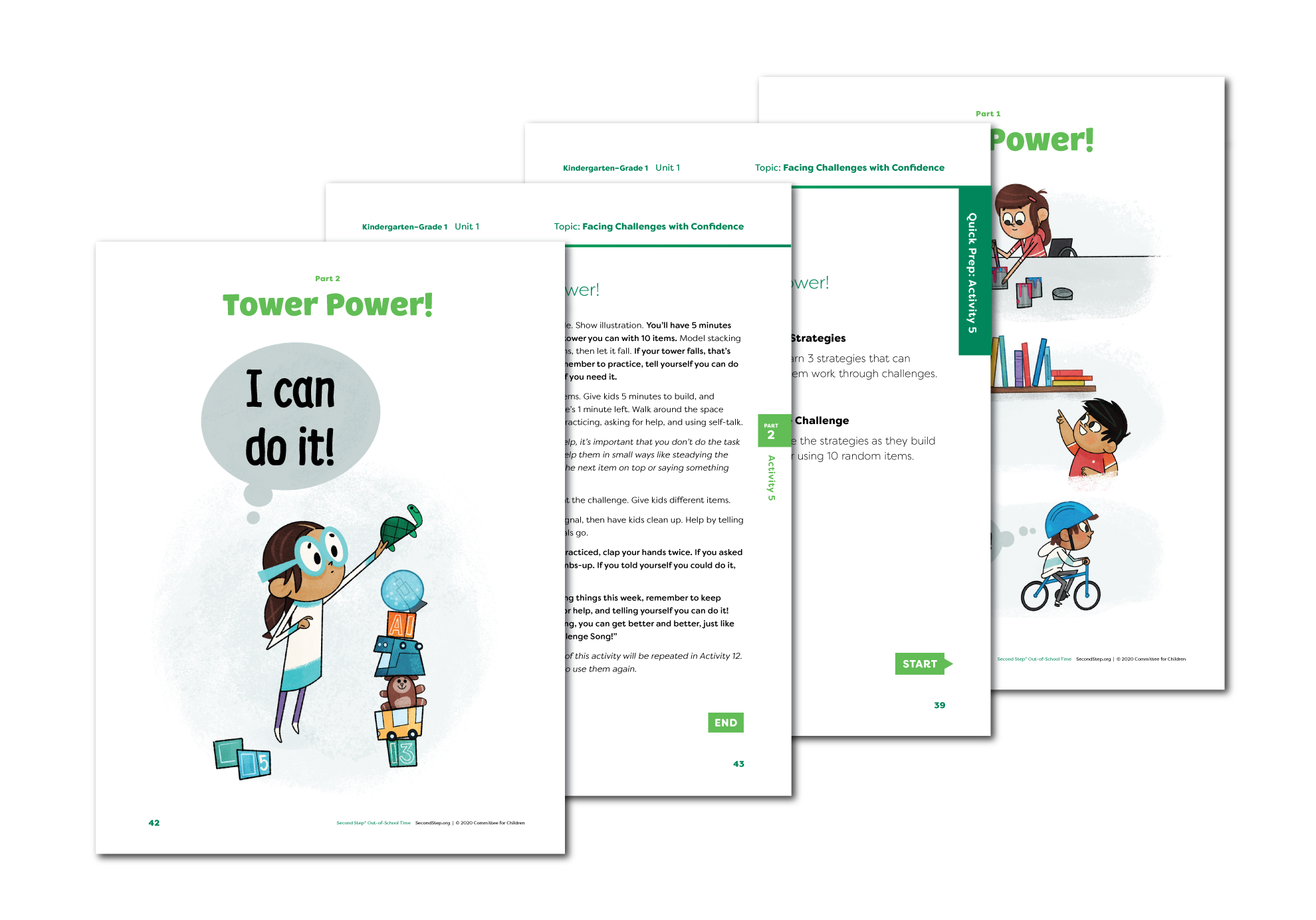
In this activity from the Growth Mindset & Goal Setting unit for Kindergarten–Grade 1, kids learn three strategies that can help them work through challenges and then use those strategies to build a tower from 10 random items.
Free Resources
Bullying Prevention Resources
Free Activities
Early, Open, Often
Abierto y a menudo
ParenTeen Connect
- 888-309-8227
- 732-384-0146
New User Registration
Forgot Password
My Math 4 Volume 2 Common Core, Grade: 4 Publisher: McGraw-Hill
My math 4 volume 2 common core, title : my math 4 volume 2 common core, publisher : mcgraw-hill, isbn : 002116195x, isbn-13 : 9780021161959, use the table below to find videos, mobile apps, worksheets and lessons that supplement my math 4 volume 2 common core., textbook resources.
- Call us toll-free
- FAQs – Frequently Asked Questions
- Contact Lumos Learning – Proven Study Programs by Expert Teachers
Follow us: Lumos Learning -->
- 2024 © Lumos Learning
- Privacy Policy - Terms of Service - Disclaimers
PARCC® is a registered trademark of PARCC, Inc. Lumos Learning, is not owned by or affiliated in any fashion with PARCC, Inc... Read More
PARCC® is a registered trademark of PARCC, Inc. Lumos Learning, is not owned by or affiliated in any fashion with PARCC, Inc., the Partnership for the Assessment of Readiness for College and Careers, nor any state of the Union. Neither PARCC, Inc., nor The Partnership for the Assessment of Readiness for College and Careers, nor any member state has endorsed this product. No portion of any fees or charges paid for any products or services Lumos Learning offers will be paid or inure to the benefit of PARCC, Inc., or any state of the Union
SBAC is a copyright of The Regents of the University of California – Smarter Balanced Assessment Consortium, which is not aff... Read More
SBAC is a copyright of The Regents of the University of California – Smarter Balanced Assessment Consortium, which is not affiliated to Lumos Learning. The Regents of the University of California – Smarter Balanced Assessment Consortium, was not involved in the production of, and does not endorse these products or this site.
ACT® Aspire™ is a registered trademark of ACT Aspire LLC., which is not affiliated to Lumos Learning. ACT Aspire LLC, was not... Read More
ACT® Aspire™ is a registered trademark of ACT Aspire LLC., which is not affiliated to Lumos Learning. ACT Aspire LLC,was not involved in the production of, and does not endorse these products or this site.
Florida Department of Education is not affiliated to Lumos Learning. Florida department of education, was not involved in the... Read More
Florida Department of Education is not affiliated to Lumos Learning. Florida department of education, was not involved in the production of, and does not endorse these products or this site.
Indiana Department of Education is not affiliated to Lumos Learning. Indiana department of education, was not involved in the... Read More
Indiana Department of Education is not affiliated to Lumos Learning. Indiana department of education, was not involved in the production of, and does not endorse these products or this site.
Mississippi Department of Education is not affiliated to Lumos Learning. Mississippi department of education, was not involved... Read More
Mississippi Department of Education is not affiliated to Lumos Learning. Mississippi department of education, was not involved in the production of, and does not endorse these products or this site.
Ohio Department of Education is not affiliated to Lumos Learning. Ohio department of education, was not involved in the prod... Read More
Ohio Department of Education is not affiliated to Lumos Learning. Ohio department of education, was not involved in the production of, and does not endorse these products or this site.
Tennessee Department of Education is not affiliated to Lumos Learning. Tennessee department of education, was not involved... Read More
Tennessee Department of Education is not affiliated to Lumos Learning. Tennessee department of education, was not involved in the production of, and does not endorse these products or this site.
Georgia Department of Education is not affiliated to Lumos Learning. Georgia department of education, was not involved... Read More
Georgia Department of Education is not affiliated to Lumos Learning. Georgia department of education, was not involved in the production of, and does not endorse these products or this site.
Missouri Department of Education is not affiliated to Lumos Learning. Missouri department of education, was not involved... Read More
Missouri Department of Education is not affiliated to Lumos Learning. Missouri department of education, was not involved in the production of, and does not endorse these products or this site.
Louisiana Department of Education is not affiliated to Lumos Learning. Louisiana department of education, was not involved... Read More
Louisiana Department of Education is not affiliated to Lumos Learning. Louisiana department of education, was not involved in the production of, and does not endorse these products or this site.
Please ensure that your password is at least 8 characters and contains each of the following:
- a special character: @$#!%*?&
- Share full article
For more audio journalism and storytelling, download New York Times Audio , a new iOS app available for news subscribers.

- April 12, 2024 • 34:23 How One Family Lost $900,000 in a Timeshare Scam
- April 11, 2024 • 28:39 The Staggering Success of Trump’s Trial Delay Tactics
- April 10, 2024 • 22:49 Trump’s Abortion Dilemma
- April 9, 2024 • 30:48 How Tesla Planted the Seeds for Its Own Potential Downfall
- April 8, 2024 • 30:28 The Eclipse Chaser
- April 7, 2024 The Sunday Read: ‘What Deathbed Visions Teach Us About Living’
- April 5, 2024 • 29:11 An Engineering Experiment to Cool the Earth
- April 4, 2024 • 32:37 Israel’s Deadly Airstrike on the World Central Kitchen
- April 3, 2024 • 27:42 The Accidental Tax Cutter in Chief
- April 2, 2024 • 29:32 Kids Are Missing School at an Alarming Rate
- April 1, 2024 • 36:14 Ronna McDaniel, TV News and the Trump Problem
- March 29, 2024 • 48:42 Hamas Took Her, and Still Has Her Husband
How One Family Lost $900,000 in a Timeshare Scam
A mexican drug cartel is targeting seniors and their timeshares..
Hosted by Katrin Bennhold
Produced by Asthaa Chaturvedi and Will Reid
With Clare Toeniskoetter and Lynsea Garrison
Edited by Brendan Klinkenberg and Michael Benoist
Original music by Marion Lozano , Rowan Niemisto , Dan Powell , Pat McCusker and Will Reid
Engineered by Chris Wood
Listen and follow The Daily Apple Podcasts | Spotify | Amazon Music
Warning: this episode contains descriptions of violence.
A massive scam targeting older Americans who own timeshare properties has resulted in hundreds of millions of dollars sent to Mexico.
Maria Abi-Habib, an investigative correspondent for The Times, tells the story of a victim who lost everything, and of the criminal group making the scam calls — Jalisco New Generation, one of Mexico’s most violent cartels.
On today’s episode

Maria Abi-Habib , an investigative correspondent for The New York Times based in Mexico City.

Background reading
How a brutal Mexican drug cartel came to target seniors and their timeshares .
There are a lot of ways to listen to The Daily. Here’s how.
We aim to make transcripts available the next workday after an episode’s publication. You can find them at the top of the page.
The Daily is made by Rachel Quester, Lynsea Garrison, Clare Toeniskoetter, Paige Cowett, Michael Simon Johnson, Brad Fisher, Chris Wood, Jessica Cheung, Stella Tan, Alexandra Leigh Young, Lisa Chow, Eric Krupke, Marc Georges, Luke Vander Ploeg, M.J. Davis Lin, Dan Powell, Sydney Harper, Mike Benoist, Liz O. Baylen, Asthaa Chaturvedi, Rachelle Bonja, Diana Nguyen, Marion Lozano, Corey Schreppel, Rob Szypko, Elisheba Ittoop, Mooj Zadie, Patricia Willens, Rowan Niemisto, Jody Becker, Rikki Novetsky, John Ketchum, Nina Feldman, Will Reid, Carlos Prieto, Ben Calhoun, Susan Lee, Lexie Diao, Mary Wilson, Alex Stern, Dan Farrell, Sophia Lanman, Shannon Lin, Diane Wong, Devon Taylor, Alyssa Moxley, Summer Thomad, Olivia Natt, Daniel Ramirez and Brendan Klinkenberg.
Our theme music is by Jim Brunberg and Ben Landsverk of Wonderly. Special thanks to Sam Dolnick, Paula Szuchman, Lisa Tobin, Larissa Anderson, Julia Simon, Sofia Milan, Mahima Chablani, Elizabeth Davis-Moorer, Jeffrey Miranda, Renan Borelli, Maddy Masiello, Isabella Anderson and Nina Lassam.
Katrin Bennhold is the Berlin bureau chief. A former Nieman fellow at Harvard University, she previously reported from London and Paris, covering a range of topics from the rise of populism to gender. More about Katrin Bennhold
Advertisement

IMAGES
VIDEO
COMMENTS
Step 1 - Understand the Problem. To help students understand the problem, I provided them with sample problems, and together we did five important things: read the problem carefully. restated the problem in our own words. crossed out unimportant information. circled any important information.
Find the perimeter and area of the picture. P= 54 cm. A= 180 cm2. A rectangular photograph measures 12 cm wide and 15 cm long. b. Find the perimeter and area of a similar photo that is double the size of the original. P= 108 cm. A= 720 cm2. A rectangular prism has a base length of 3 cm, a base width of 2 cm, and a height of 5 cm.
3. 4. 5. TED-Ed lessons on the subject Problem Solving. TED-Ed celebrates the ideas of teachers and students around the world. Discover hundreds of animated lessons, create customized lessons, and share your big ideas.
A runner tries to keep a consistent stride length in a marathon. But, the length will change during the race. A runner has a stride length of 5 feet for the first half of the race and a stride length of 4.5 feet for the second half. 13. A marathon is 26 miles 385 yards long. That is about 1.4 × 105 feet.
Introduction. (10 minutes) Bring students together in a circle, either seated or standing. Bring blocks with you to the circle. Show the student the blocks and ask them to watch you build a tall castle. After you build it, bring out two figurines that you would like to play with in the castle. Say out loud, "Hmm....there seems to be a problem.
1. Identify the problem. Clearly state the problem. (Short, sweet and to the point. This is the "big picture" problem, not the specific project you have been assigned.) 2. Establish what you want to achieve. Completion of a specific project that will help to solve the overall problem.
The Algebra 1 course, often taught in the 9th grade, covers Linear equations, inequalities, functions, and graphs; Systems of equations and inequalities; Extension of the concept of a function; Exponential models; and Quadratic equations, functions, and graphs. Khan Academy's Algebra 1 course is built to deliver a comprehensive, illuminating, engaging, and Common Core aligned experience!
A 60-watt light bulb uses 60 watt hours of electricity in 1 hour. Suppose everyone in the United States left one unneeded 60 watt light bulb on for one hour every day for a year. 9. Electricity is billed in kilowatt hours. So 60 watt hours is equal to sixty divided by one thousand.
Hone your skills in solving two-step equations because it will serve as your foundation when solving multi-step equations. I prepared eight (8) two-step equations problems with complete solutions to get you rolling. ... please feel free to review my other lesson about two-step equations. Click the link below to get there. Enjoy! Solving Two ...
Is there extraneous information? Is this problem similar to another problem you have solved? Step 2: Devise a Plan: Below are some strategies one might use to solve a problem. Can one (or more) of the following strategies be used? (A strategy is defined as an artful means to an end.) 1. Guess and test.
The Problem solving in practice interactive worksheet introduces some of the themes from the full lesson plan and gives students some practical strategies for problem solving, including introducing the six stages of problem solving. The worksheet can be printed or completed digitally, so can be used flexibly to give students practise putting ...
Lesson 2-4 Reasoning in Algebra 103 and OC S OA S Reasoning in Algebra ALGEBRA Check Skills You'll Need GO for Help 2-4 103 1. Plan Objectives ... Practice and Problem Solving EXERCISES For more exercises, see Extra Skill, Word Problem, and Proof Practice. A Practice by Example Transitive or Substitution Prop. of Equality
Finding a suitable solution for issues can be accomplished by following the basic four-step problem-solving process and methodology outlined below. Step. Characteristics. 1. Define the problem. Differentiate fact from opinion. Specify underlying causes. Consult each faction involved for information. State the problem specifically.
In this lesson, students will learn how to identify when and where to work on solving a problem, and who should be included. Lesson Plan (PDF) Lesson Presentation. Grade 6. Unit 4, Lesson 23: Respectful Communication. ... Unit 2, Lesson 10: Environmental Factors that Contribute to Bullying.
Developed as part of our award-winning PlanIt scheme of work, this lesson is the first in a series of three on addition and subtraction problem-solving for Year 4 Maths. For more resources like this two-step problem-solving lesson, take a look at the following downloadable packs, lesson 2 and 3 in this series:
Exercise 3. Exercise 4. Exercise 5. Exercise 6. Exercise 7. Exercise 8. Chapter 14: Chapter Fourteen. Find step-by-step solutions and answers to Algebra 2 Practice and Problem Solving Workbook - 9780133688894, as well as thousands of textbooks so you can move forward with confidence.
My Math 4 Volume 2 Common Core grade 4 workbook & answers help online. Grade: 4, Title: My Math 4 Volume 2 Common Core, Publisher: McGraw-Hill, ISBN: 002116195X ... Lesson 4: Problem-Solving Investigation: Make an Organized List. apps. videocam. create. Lesson 5: Convert Metric Units. apps. videocam. create. Lesson 6: Solve Measurement Problems ...
Free math problem solver answers your algebra homework questions with step-by-step explanations.
This video covers lesson 3.7 Problem Solving-Multiply 2-digit Numbers on pages 131-134 of the 4th grade GO Math textbook.
LESSON 6-4 Practice and Problem Solving: A/B 1. x = 3 2. p = −3 3. a = 4 4. n = −2 5. g = 2 6. k = −18 7. s = 18 8. c = −8 9. a = −6 10. v = 9 11. x = −2 12. d = 24 13. 24s + 85 = 685; s = $25 14. x + x + 1 = 73; 36 and 37 Practice and Problem Solving: C 1. 2x − 17 = 3; ...
You can find the source for the homework pages at the link below. click on the "full module" PDF:https://www.engageny.org/resource/grade-2-mathematics-module-4
PROBLEM SOLVING Lesson 2.q COMMON CORE STANDARD CC.5.NBT.6 Perform operations with multi-digit whole work. numbers and with decimals to hundredths. 208 baseball cards 16 16 Tony Duane 16 16 16 16 16 16 208 + 16 16 13 = 16 16 16 16 192 cards 240 pages 4 guppies 248 songs Tony: 16 cards; 2. Hallie has 10 times as many pages to read for her
Original content Copyright © by Houghton Mifflin Harcourt. Additions and changes to the original content are the responsibility of the instructor.
April 2, 2024 • 29:32. Kids Are Missing School at an Alarming Rate. April 1, 2024 • 36:14. Ronna McDaniel, TV News and the Trump Problem. March 29, 2024 ...